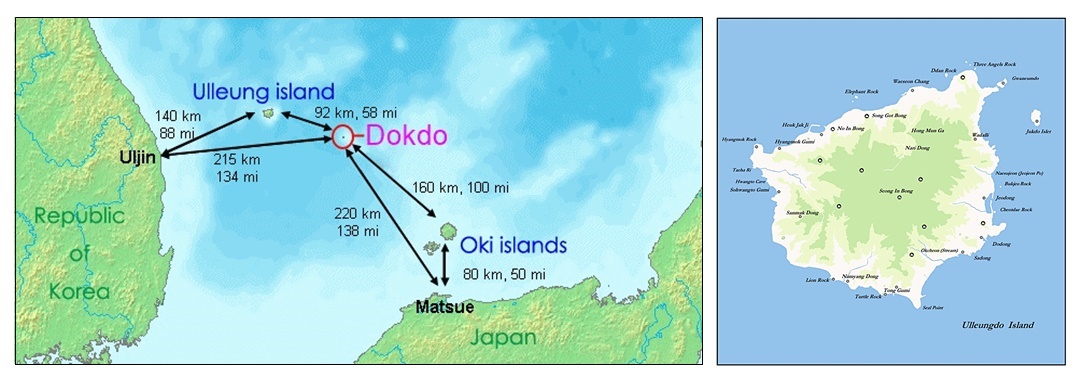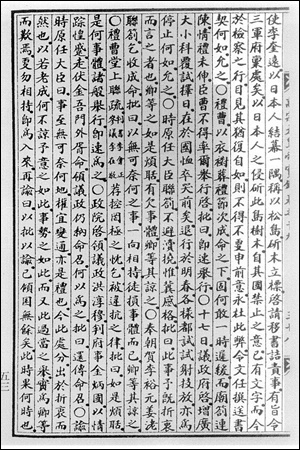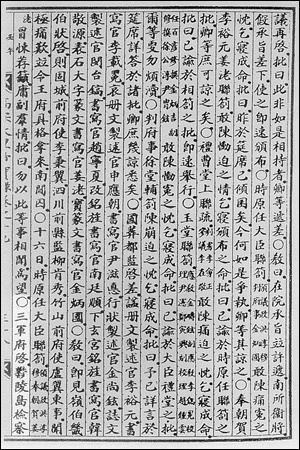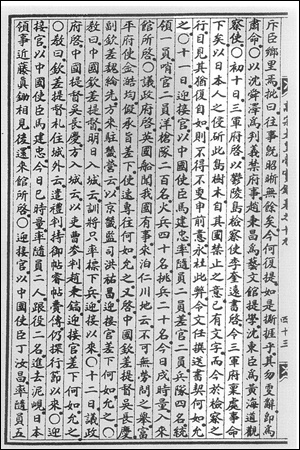Japanese Loggers Continue Their Intrusion into Chosun’s Ulleungdo Island
As the previous pages described, the civilian invasion by Japanese was straining Japanese – Korean relations. In response the Korean government decided to discontinue their abandoned island policy on Ulleungdo and implemented policies to populate and settle the island. On April 29th 1882 A Korean inspector named Lee Gyu Won arrived on Ulleungdo and investigated the situation there. There he found many Japanese felling Ulleungdo’s trees and had erected a sign calling the island “Matsushima” (松島-Songdo in Korean).
Above left: An overall map of the Ulleungdo – Dokdo region showing distances to nearest Japanese and Korean landfalls. Above right: A map of Korea’s Ulleungdo Island.
A Translation of Chosun’s Records Related to Japanese Illegal Tree Felling on Ulleungdo
“An official from the Ministry of Defense is making a request to the King as follows. “While inspecting Ulleungdo, Lee Kyuwon found out that some Japanese nationals had erected a tent in a corner along with a wooden sign calling the island “Songdo” and he suggested to your highness that an official letter reprimanding such behavior should be made by our Defense Ministry. We’ve already sent a letter urging them (Japan) to ban their nationals from logging on Ulleungdo. However, when inspector Lee Kyuwon went down there to check in person recently, the situation hadn’t changed. Thus it is imperative we send another letter repeatedly laying stress on the contents of the last one to stop this problem once and for all. But may I request this letter be done by (official title) this time. To this the King gave his consent…..”
A short while later, yet another complaint was sent to the king regarding the illegal logging by the Japanese on Ulleungdo. It reads as follows;
“..On the 10th of July an official from the Military Department says to the King, With regard to Lee Kyuwon’s Ulleungdo report, your highness ordered that we take care of it. We already sent an official letter calling on Japan to ban their people from invading the island for logging. However when the inspector went down there this time to check there were still Japanese people doing the same thing as before. This makes it necessary for us to write a document emphasizing the contents of the old letter to stop these illegal activities for good. May I suggest a Daejaehak (official title) for this task..?”
To this, the King agreed….”
Here, we can see that Japan’s once hard-line policy toward Japanese trespassers has softened almost to the point of indifference. As the document states the Chosun Government had already lodged official complaints with the Japanese Foreign Ministry to no avail. As it was in other parts of Asia at this time, the Japanese had begun to instigate a policy of civilian invasion in neighbouring countries and had turned a blind eye to squatters or illegal residents.
The Japanese Government Temporarily Complies With Korea’s Demands
Fifty years earlier, under the strict isolationist policies of the Shogunate, Japanese nationals were executed for violating Japan’s promise to stay off of Ulleungdo. However, under the new Meiji government’s policy the Japanese government’s punishments were little more than a slap on the wrists. Even so, the Japanese government graciously complied with Korea’s demands and in 1883 a ship arrived and forcibly removed these Japanese squatters.
March 1st 1883 – Japan Announces a Travel Ban Toward Ulleungdo
内達案
北緯三十七度三十分東経百三十度四十九分二位スル日本称松島一名竹島朝鮮称鬱陵島ノ儀ハ従前彼我政府ノ議定ノ儀モ有之日本人妄リニ渡航上陸不相成候條心得違ノ者無之様各地方長官に於テ諭達此旨及内達候也
明治十六年三月一日
太政大臣
Translation:
“…Draft of Official Notice
The island that Japan calls Matsushima or Takeshima and that Korea calls Ulleungdo, located at 37 degrees 30 minutes north latitude and 130 degrees 49 minutes east longitude, is the island that Japan and Korea had an document of agreement saying that Japanese would not sail to nor land on the island without reason. We hereby notify this fact to the director of each local government so that there will be no confusion about it.
March 1st, 1883
The Dajo Daijin…”
An Analysis of Japanese Activity on Ulleungdo in the Early Meiji Era

On March 1st 1883, the Japanese government made yet another of many declarations reaffirming Korean ownership over Ulleungdo Island.
The original record can be seen to the right.
Unlike the Shogunates previous declarations of 1696 and 1837 Dokdo Island was not mentioned. Also this record did not demand Japanese voyagers stay near the Japanese mainland or avoid foreign contact. Thus, we can see how Japan’s attitude toward foreign lands had changed.
However, while appearing to comply with Korea’s demands Meiji Japan’s Empire was insidiously expanding in all four directions of the compass. In reality, the Japanese government’s travel ban on Ulleungdo had little effect. Records show LaPorte’s 1899 Report on Ulleungdo Situation by the late 1890s, large numbers of Japanese arrived on Ulleundo to the point the Korean Government could no longer govern over the distant Ulleungdo region. This was the historical backdrop to Japan’s 1905 annexation of Dokdo Island.
 On March 1st 1883, the Japanese government made yet another of many declarations reaffirming Korean ownership over Ulleungdo Island. The original record can be seen to the right.
On March 1st 1883, the Japanese government made yet another of many declarations reaffirming Korean ownership over Ulleungdo Island. The original record can be seen to the right.




